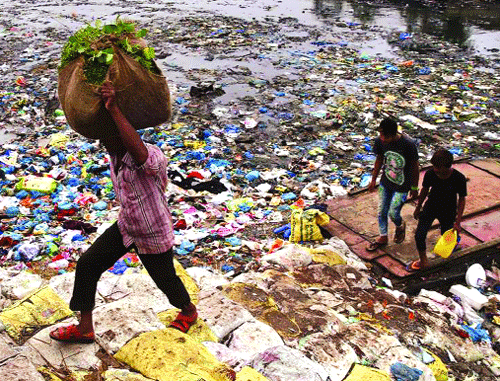At the CoP next month, India plans to display Mahatma Gandhi’s pattern of simple living. This is laudable. In reality, many Indians are adopting lifestyles which are at variance with the Father of the Nation’s objectives
On Mahatma Gandhi’s birthday this year, India handed over at the UN headquarters in New York, its instruments of ratification of the Paris agreement on climate change. This was symbolically an important occasion to acknowledge Mahatma Gandhi’s acute consciousness on India’s need for pursuing a pattern of development totally in harmony with nature. When the Mahatma was asked whether he would not want India to reach the same level of prosperity as Britain, he stated that it took Britain to use half the resources of this planet to reach its level of prosperity, and asked, “How many planets would a country like India requireIJ”
We live today in a world of over seven billion people, representing unprecedented growth in the world’s population, which at the start of the 20th century stood at a value between 1.56 and 1.71 billion, and which is projected to increase to over 11 billion by 2100. If such a large number of human beings were to attain the same consumerist standards of living as the most resource intensive societies on earth, then indeed, we would need a number of planets to meet the demand imposed by us on our natural resources.
At the forthcoming Conference of the Parties (CoP) to be held in Marrakesh in November this year, India plans to display in its pavilion the Mahatma’s pattern of simple living, which is indeed laudable. But, in reality, most Indians who have the means today — and a large number do — are adopting standards of living which deviate substantially from Gandhian principles and practice.
No one can support lifestyles which remain frugal and self-denying in a major part of the world when in the developed countries the consumption of goods and services continues to increase at levels without any restraint or limit. The term climate justice has been coined and used frequently to highlight the inequity in the current situation, wherein the problem of increased concentration of greenhouse gases (GHGs) has been caused predominantly by the industrialised world, while the worst victims of the impacts of climate change live in the poorest nations.
India is particularly vulnerable to the impacts of climate change, and the recent occurrence of droughts and floods — caused by extreme precipitation events — are projected to increase in frequency and intensity. The Intergovernmental Panel on Climate Change (IPCC) in its Fifth Assessment Report (AR5), clearly pointed out, “Rural areas are expected to experience major impacts on water availability and supply, food security, infrastructure and agricultural incomes, including shifts in the production areas of food and non-food crops around the world.”
While cities and towns in India certainly require to put in place climate resilience measures, particularly in coastal areas which face the growing threat of sea level rise, the vast rural population of the country remains vulnerable without explicit integration of adaptation measures to counter the impacts of climate change with development strategies. India has to take climate change far more seriously both in its domestic policies and actions as well as in the international sphere, where in the aggregate emission levels and pathways being followed currently will lead to temperature increases that would have frightening consequences.
The National Action Plan on Climate Change was developed with considerable thought and deliberation by the Government of India, and with active involvement of the State Governments. But much of its original momentum has been dissipated with actions envisaged collapsing into routine bureaucratic programmes confined to Government departments, without adequate participation by the public.
The AR5 has stated, “Without additional mitigation efforts beyond those in place today, and even with adaptation, warming by the end of the 21st century will lead to high to very high risk of severe, widespread and irreversible impacts globally.”
The Paris agreement on climate change, while a remarkable step forward, does not provide any assurance that temperature increase by the end of this century relative to pre-industrial levels, can be limited to two degree Celsius or below. It essentially provides an opportunity for nations and societies across the globe to generate the ambition for major cuts in their own emissions of greenhouse gases, and thus ensure an aggregate response that would keep temperature increase below two degree Celsius or even 1.5 degrees, as is now being scientifically assessed.
There are multiple co-benefits from reduced emissions of GHGs, such as lower levels of environmental damage at the local level, higher levels of energy security, higher assurance of food security and possibly higher levels of employment with greater reliance on decentralised forms of energy supply from renewable resources. For India, the issue of energy security is a paramount consideration in development strategy, since this country is a major importer of fossil fuels, a fact which we cannot be oblivious to even with the current lull in global oil prices.
On the issue of lifestyle changes, India has to take the lead in deviating from the consumerist and resource intensive patterns of much of the industrialised world. The externalities that we are imposing on the environment and the global commons should universally be reflected in costs and prices of goods and services in every country. This should be pursued as an agenda in the following CoPs wherein the implementation of the Paris agreement should now be defined by specific actions and equitable policies such as a price on carbon for those who are at high levels of carbon intensive economic activities.
Emphasis should also be placed on sustainable lifestyles, because as the AR5 has stated, “Behaviour, lifestyle and culture have a considerable influence on energy use and associated emissions, with high mitigation potential in some sectors, in particular when complementing technological and structural change. Emissions can be substantially lowered through changes in consumption patterns, adoption of energy savings measures, dietary change and reduction in food wastes.”
An appropriate tribute to Mahatma Gandhi would lie in our adopting lifestyles and development patterns which acknowledge the reality that we have only one planet to live on. This is where the youth of India should set the pace and take a lead as a model for the rest of the world.
(The writer is former chairman, TERI)
























